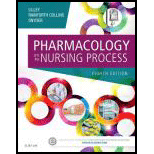
To describe:
Concepts related to carcinogenesis.
Concept introduction:
Cancer cells are characterized by the uncontrolled proliferation of abnormal cells, invasion, and metastasis. Drugs, which are used to treat cancer is generally known as chemotherapeutic drugs or antineoplastic drugs. Antineoplastic drugs are broadly classified into two categories based on targeting the phases of the cell cycle (cell cycle specific drugs and cell cycle non-specific drugs). The major adverse effects of chemotherapy are immune suppression, gastrointestinal distress, fatigue, anemia, nausea, vomiting, hair loss, and stomatitis. Most of the antineoplastic drugs cause adverse effects on rapidly dividing cells (for example, bone marrow cells, GI tract cells, and hair follicles).
Explanation of Solution
Carcinogenesis is also known as tumorigenesis, is the progression of cancer. Cancer is a group of diseases in which normal cell is transformed into genetically abnormal cells. Cancer is characterized by genetic or cellular changes, uncontrolled growth of cells, invasion, metastasis, and antiapoptosis. Cancer cells lack differentiation and maturation into specialized cells. Cancer cells invade adjacent tissues and travel to other parts of the body through the blood or lymphatic system.
The clone is a single cancer cell or group of cancer cells and that is produced from the genetically identical parent cell. The establishment of the new clone of cancer cells paves the way for metastasis. Spread of cancer cells from their original site to other organs or parts of the body is known as metastasis.
Carcinogenesis is a multistep process, there are four major stages are found in carcinogenesis are initiation (alteration or mutation of genes by spontaneous or induced), promotion (invasion and clonal expansion), conversion (genetic changes), and progression (genetic as well as
The term tumor, malignancy, and neoplasm are synonyms for cancer. Neoplasm refers as a mass of new tissue or new cells. The tumor is classified into two: benign and malignant. Uniform size and shape of cells without invasion is called benign tumor and it may be harmless. Invasion of cancer cells to their surrounding area and other parts is known as a malignant tumor.
Various types of cancer are classified based on tissues, such as sarcomas (connective tissues), carcinomas (epithelial tissues), lymphomas (lymphatic tissues), leukemias (blood), and cancers of nervous tissues.
Carcinogenesis is the progression of cancer or tumor. It is a multistep process and mainly categorized into the benign tumor and the malignant tumor.
Want to see more full solutions like this?
Chapter 45 Solutions
Pharmacology and the Nursing Process, 8e
- true or false any practice employee is authorized to and should communicate collection guidelines with practice?arrow_forwardrtrue or false equesting a listing of specific creditreferences during patient intake os an acceptable business practice?arrow_forwardgive an overview on the respiratory assessmentarrow_forward
- explain an abdominal exam?arrow_forwardDiscuss β -Lactam antibiotics under the following subheadings Classifications of penicillins Classification of Cephalosporins General Mechanism of Actions Clinical Indications of penicillins and cephalosporins Adverse effects of β-lactamsarrow_forwarda. Define neoplasm b. Differentiate between benign and malignant tumours c. Describe the molecular basis of cancerarrow_forward
- differentiate the extra heart sounds S3,S4, murmurs and gallopsarrow_forward• Define shock and list types of shock • Discuss pathogenesis of septic shock. • Enumerate the stages of shock. • Define oedema and describe the pathophysiologic mechanisms of oedema with examples.arrow_forwardDiscuss Hypertension under the following headings: Definition Diagnosis Non-pharmacological intervention Drugs Classification Management of a Hypertensive emergencyarrow_forward
- Explain how the answer could be 2 or 1.8 WITHOUT changing the questionarrow_forwardoverview of the neurological system, cranial nerves and what part of the body it innervatesarrow_forwarddifferentiate structure and function of the peripheral vascular system. what are the normal and abnormal findings of the peripheral arterioles and peripheral venous systemarrow_forward
 Phlebotomy EssentialsNursingISBN:9781451194524Author:Ruth McCall, Cathee M. Tankersley MT(ASCP)Publisher:JONES+BARTLETT PUBLISHERS, INC.
Phlebotomy EssentialsNursingISBN:9781451194524Author:Ruth McCall, Cathee M. Tankersley MT(ASCP)Publisher:JONES+BARTLETT PUBLISHERS, INC. Gould's Pathophysiology for the Health Profession...NursingISBN:9780323414425Author:Robert J Hubert BSPublisher:Saunders
Gould's Pathophysiology for the Health Profession...NursingISBN:9780323414425Author:Robert J Hubert BSPublisher:Saunders Fundamentals Of NursingNursingISBN:9781496362179Author:Taylor, Carol (carol R.), LYNN, Pamela (pamela Barbara), Bartlett, Jennifer L.Publisher:Wolters Kluwer,
Fundamentals Of NursingNursingISBN:9781496362179Author:Taylor, Carol (carol R.), LYNN, Pamela (pamela Barbara), Bartlett, Jennifer L.Publisher:Wolters Kluwer, Fundamentals of Nursing, 9eNursingISBN:9780323327404Author:Patricia A. Potter RN MSN PhD FAAN, Anne Griffin Perry RN EdD FAAN, Patricia Stockert RN BSN MS PhD, Amy Hall RN BSN MS PhD CNEPublisher:Elsevier Science
Fundamentals of Nursing, 9eNursingISBN:9780323327404Author:Patricia A. Potter RN MSN PhD FAAN, Anne Griffin Perry RN EdD FAAN, Patricia Stockert RN BSN MS PhD, Amy Hall RN BSN MS PhD CNEPublisher:Elsevier Science Study Guide for Gould's Pathophysiology for the H...NursingISBN:9780323414142Author:Hubert BS, Robert J; VanMeter PhD, Karin C.Publisher:Saunders
Study Guide for Gould's Pathophysiology for the H...NursingISBN:9780323414142Author:Hubert BS, Robert J; VanMeter PhD, Karin C.Publisher:Saunders Issues and Ethics in the Helping Professions (Min...NursingISBN:9781337406291Author:Gerald Corey, Marianne Schneider Corey, Cindy CoreyPublisher:Cengage Learning
Issues and Ethics in the Helping Professions (Min...NursingISBN:9781337406291Author:Gerald Corey, Marianne Schneider Corey, Cindy CoreyPublisher:Cengage Learning





